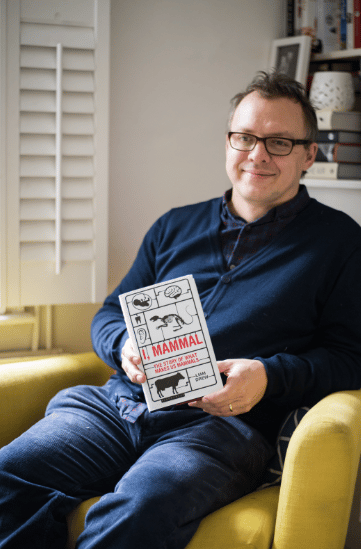Local author Liam Drew tells the Times what his recent hit book – I, Mammal: The Story
of What Makes us Mammals – is all about…
I, MAMMAL was born largely of serendipity. As an academic scientist I was always very
interested in communicating research findings to a wider audience, and in a bid to get better at this I’d started taking evening classes in non-fiction writing.
In 2011, needing something to write about for my homework, I was playing football, when a ball struck me rather painfully in a certain part of my anatomy.
Some weeks later, I handed my classmates an essay about the possible reasons for most male mammals carrying their essential reproductive organs outside of their bodies. (And, no, it isn’t just about keeping them cool.)
They liked the story – a mixture of amused befuddlement and serious science – and
eventually it was published by the American magazine Slate, where it caught the attention of an editor at Bloomsbury.
When they wrote to me to ask if I’d ever considered writing a book, I had a very young
daughter whose arrival had completely blown me away. I’d been amazed by how instinctively parenting had come, mesmerised by the ultrasound images of my daughter growing in a womb, then astonished by what an obsession milk and its provision had become…
Thinking of a theme for a book, it was immediately clear that these were all very much
aspects of being not human but a mammal. I quickly decided that I wanted to explore what it meant to be a mammal. So, whereas most evolutionary accounts of how humans evolved focus on what is unique to us – our large brains, talent for language and upright postures, that sort of thing – I wanted to grapple with much older biological history to ask how this type of animal had evolved. And to look at what we owed to that history.
My initial plan, the one I pitched to Bloomsbury, was to simply list the things that make mammals different from other animals – milk, hair, big brains with a unique type of cerebral cortex, molar teeth, and so on – then write a chapter on how and why each of these traits had evolved. While this remains the basic structure of the book, the chapters all became very interlinked: A mammal isn’t simply a hairy creature that grows up drinking milk, the essence of a mammal lies in the connections between these traits.
From the beginning, I wanted the book to be accessible, and so it’s written in a very
conversational tone, with plenty of personal anecdotes and lots of looking across the
mammalian family and exploring the many, wonderfully diverse types of animals that operate on basic mammalian principles.
And, unlike in my academic career where I always had to be very serious in public, here,
when I encountered things that surprised me, I allowed myself to say ‘Wow! That’s incredible’. My book has just been published in America, something I am very excited about. One of the nicest side effects of writing it is that it made me a much more careful observer of nature. Though our local mammals are fairly prosaic, I found myself walking around Dunorlan Park, say, watching the rabbits in a much more interested and appreciative manner.
The book, which took about two and a half years to write, ends with me and a squirrel staring at each other in the grounds of Charles Darwin’s old house in Downe near Orpington. Standing there in a space where one of the greatest intellects of all time had lived and observing the animals in his garden, I watched the squirrel skip on, his tail echoing the arching movements of his body, and IÂ simply felt lucky to be here.
I, Mammal: The Story of What Makes us Mammals, by Liam Drew, is published by
Bloomsbury and priced £16.99








